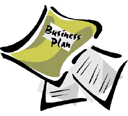This section covers daily operation of the business: the location, equipment, people, processes, and surrounding environment.
 Production
Production
How and where are your products or services produced?
Explain your methods of:
- Production techniques and costs
- Quality control
- Customer service
- Inventory control
- Product development
Location
What are the qualities you need in a location? Describe the type of location you’ll have.
Physical requirements:
- Amount of space
- Type of building
- Zoning
- Power and other utilities
Access:
Does your location need convenient access to either transportation or to suppliers?
Do you require easy walk-in access?
Do you have any additional requirements, such as: parking and proximity to freeway, airports, railroads, and shipping centers?
If your proposed facility is important to your business (for example, a manufacturing facility), include a drawing or layout of your proposed facility.
Do you plan to build a facility? Most start up companies can’t afford to put capital into construction. However, if you are planning to build, you’ll need to include costs and specifications will be a big part of in your plan.
Cost: Estimate your expenses for the facility. You need to include any expenses for rent, maintenance, utilities, insurance, and any necessary remodeling costs to make the space suit your needs. These numbers will become part of your financial plan.
What are your planned business hours?
Legal Environment
Describe the following:
- Licensing and bonding requirements
- Permits
- Health, workplace, or environmental regulations
- Special regulations covering your industry or profession
- Zoning or building code requirements
- Insurance coverage
- Trademarks, copyrights, or patents (pending, existing, or purchased)
Personnel
- Number of employees
- Type of labor (skilled, unskilled, and professional)
- Where and how will you find the right employees?
- Quality of existing staff
- Pay structure
- Training methods and requirements
- Who does which tasks?
- Do you have schedules and written procedures prepared?
- Have you drafted job descriptions for employees? If not, take time to write some. They really help internal communications with employees.
- For certain functions, will you use contract workers in addition to employees?
Inventory
- What kind of inventory will you keep: raw materials, supplies, finished goods?
- Average value in stock (i.e., what is your inventory investment)?
- Rate of turnover and how this compares to the industry averages?
- Seasonal buildups?
- Lead-time for ordering?
Suppliers
Identify key suppliers:
- Names and addresses
- Type and amount of inventory furnished
- Credit and delivery policies
- History and reliability
Do you have backup suppliers for critical items)?
Can you foresee any shortages or short-term delivery problems?
Will your supply costs be steady or fluctuating? If fluctuating, how would you deal with changing costs?
Credit Policies
- Do you plan to sell on credit?
- Is it really important that your business sell on credit? Is it customary in your industry and expected by your clientele?
- If yes, what policies will be in place for extending credit: who will get credit and how much?
- What procedures will be in place for determining creditworthiness of new applicants?
- What type of terms will you offer your customers (how much credit will you extend, when will you require payment)?
- Do you plan to offer prompt payment discounts? (Only offer if it is usual and customary in your industry.)
- Do you know what extending credit costs your business? Have you calculated the costs into your product and services prices?
Managing Your Accounts Receivable
If you do extend credit, you should use an aging chart to track how much of your money is tied up in credit given to customers and to alert you to slow payment problems. A receivables aging looks like the following table:
|
|
Total
|
Current
|
30 Days
|
60 Days
|
90 Days
|
Over 90 Days
|
| Accounts Receivable Aging | ||||||
If you extend any credit, you must create a policy for dealing with slow-paying customers:
- When do you make a phone call?
- When do you send a letter?
- Will you use an outside collection agency?
- When do you get your attorney to threaten?
Managing Your Accounts Payable
Your accounts payable need to be similarly aged: what you owe to your suppliers. Creating a similar table helps you plan whom to pay and when. If you pay too early, you deplete your cash, if you pay too late, it can cost you valuable discounts and can damage your credit. (Hint: If you know you will be late making a payment, call the creditor before the due date.)
Do your prospective vendors offer prompt payment discounts? What are the discounts?
A payables aging looks like the following table.
|
|
Total
|
Current
|
30 Days
|
60 Days
|
90 Days
|
Over 90 Days
|
| Accounts Payable Aging | ||||||
I am having issues downloading this.